| dc.contributor.author | Bruijning, Marjolein | |
| dc.contributor.author | Fossen, Erlend Ignacio Fleck | |
| dc.contributor.author | Jongejans, Eelke | |
| dc.contributor.author | Vanvelk, Héléne | |
| dc.contributor.author | Raeymaekers, Joost A.M. | |
| dc.contributor.author | Govaert, Lynn | |
| dc.contributor.author | Brans, Kristien I. | |
| dc.contributor.author | Einum, Sigurd | |
| dc.contributor.author | De Meester, Luc | |
| dc.date.accessioned | 2022-03-02T14:50:34Z | |
| dc.date.available | 2022-03-02T14:50:34Z | |
| dc.date.created | 2021-12-02T16:13:33Z | |
| dc.date.issued | 2021 | |
| dc.identifier.citation | Bruijning, M., Fossen, E.I.F., Jongejans, E., Vanvelk, H., Raeymaekers, J.A.M., Govaert, L., Brans, K.I., Einum, S. & De Meester, L. (2021). Host–parasite dynamics shaped by temperature and genotype: quantifying the role of underlying vital rates. Functional Ecology, 36(2), 485-499. doi: | en_US |
| dc.identifier.issn | 1365-2435 | |
| dc.identifier.uri | https://hdl.handle.net/11250/2982620 | |
| dc.description.abstract | Global warming challenges the persistence of local populations, not only through heat-induced stress, but also through indirect biotic changes. We study the interactive effects of temperature, competition and parasitism in the water flea Daphnia magna. We carried out a common garden experiment monitoring the dynamics of Daphnia populations along a temperature gradient. Halfway through the experiment, all populations became infected with the ectoparasite Amoebidium parasiticum, enabling us to study the interactive effects of temperature and parasite dynamics. We combined Integral Projection Models with epidemiological models, parameterized using the experimental data on the performance of individuals within dynamic populations. This enabled us to quantify the contribution of different vital rates and epidemiological parameters to population fitness across temperatures and Daphnia clones originating from two latitudes. Interactions between temperature and parasitism shaped competition, where Belgian clones performed better under infection than Norwegian clones. Infected Daphnia populations performed better at higher than at lower temperatures, mainly due to an increased host capability of reducing parasite loads. Temperature strongly affected individual vital rates, but effects largely cancelled out on a population-level. In contrast, parasitism strongly reduced fitness through consistent negative effects on all vital rates. As a result, temperature-mediated parasitism was more important than the direct effects of temperature in shaping population dynamics. Both the outcome of the competition treatments and the observed extinction patterns support our modelling results. Our study highlights that shifts in biotic interactions can be equally or more important for responses to warming than direct physiological effects of warming, emphasizing that we need to include such interactions in our studies to predict the competitive ability of natural populations experiencing global warming. | en_US |
| dc.language.iso | eng | en_US |
| dc.publisher | Wiley | en_US |
| dc.rights | Navngivelse 4.0 Internasjonal | * |
| dc.rights.uri | http://creativecommons.org/licenses/by/4.0/deed.no | * |
| dc.title | Host–parasite dynamics shaped by temperature and genotype : quantifying the role of underlying vital rates | en_US |
| dc.type | Peer reviewed | en_US |
| dc.type | Journal article | en_US |
| dc.description.version | publishedVersion | en_US |
| dc.rights.holder | © 2021 The Author(s) | en_US |
| dc.subject.nsi | VDP::Matematikk og Naturvitenskap: 400::Zoologiske og botaniske fag: 480::Økologi: 488 | en_US |
| dc.source.pagenumber | 485-499 | en_US |
| dc.source.volume | 36 | en_US |
| dc.source.journal | Functional Ecology | en_US |
| dc.source.issue | 2 | en_US |
| dc.identifier.doi | 10.1111/1365-2435.13966 | |
| dc.identifier.cristin | 1963707 | |
| dc.relation.project | The Research Council of Norway: 223257 | en_US |
| dc.relation.project | The Research Council of Norway: 230482 | en_US |

